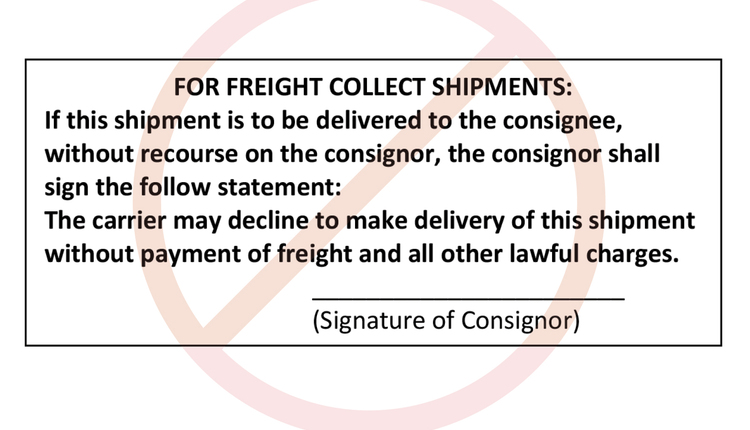The previous installment of PARCEL Counsel provided an overview of claims for concealed damage, i.e., claims to recover for loss or damage when the problem was not in plain view at the time of delivery and not reported on a delivery receipt. In this issue we will focus on the various time limits for filing these claims.
Always keep in mind that various entities act in varying capacities when providing transportation services. They may be acting as a regulated motor carrier, a deregulated domestic air carrier, an international air carrier, or even as a form of intermediary. This is certainly true with respect to UPS and FedEx.
Many parcel shippers use the services of motor carriers offering both truckload and less-than-truckload services. If these carriers are operating in interstate commerce, they are subject to provisions of a federal law that has been on the books for more than 100 years ----- the Carmack Amendment. The relevant part reads:
“A carrier may not provide by rule, contract, or otherwise, a period of less than 9 months for filing a claim against it under this section and a period of less than 2 years for bringing a civil action against it under this section.”
Thus, the minimum period for filing a loss or damage claim that a regulated motor carrier can establish in its tariff, service guide, or bill of lading is nine months from the date of delivery…. including claims for concealed damage.
Generally speaking, all of the motor carriers used by parcel shippers have established a tariff rule that requires claims for loss or damage to be filed within nine months. As discussed in the August issue, those that belong to the NMFC usually “incorporate by reference” the provisions of Item 300135 relating to claims for concealed damage.
One interesting exception to the general pattern is the FedEx Ground Tariff, which has a provision that states:
“In the case of a claim for concealed loss or damage that is not discovered at the time of delivery, the sender or recipient must notify FedEx Ground as promptly as possible after the discovery of the damage, and in any event no later than 21 days after the date of delivery.”
The tariff also states “Failure to comply with any of the above conditions will result in the denial of a claim.” Since this language appears to be in violation of the federal statute quoted above, I sought out the opinion of George Pezold, the Executive Director of the Transportation and Logistics Council, Inc. and Co-Author of the text Freight Claims in Plain English”, 4th Edition. According to Mr. Pezold:
“To the extent FedEx declines a claim because a claimant failed to file “notice” of a concealed damage claim within 21 days, such a declination would be invalid. The Carmack Amendment allows a carrier to establish a period of not less than 9 months to file a claim. As long as the claimant submits its claim in writing within 9 months, then its claim will be timely filed and must be considered on its merits.”
Domestic air carriers have not been subject to economic regulation for many years. Generally speaking, their terms and conditions will be enforceable if incorporated by reference in the language appearing on the Airbill or other form of receipt given to the shipper when the carrier’s driver picks up a shipment.
Even if space permitted examples of such provisions relating to claim filing requirements, I would hesitate to do so. This is because the only terms and conditions that are relevant to a claim are the terms and conditions of the carrier who transported the shipment.
International air carriers are governed by the Warsaw Convention, an international treaty. Under Article 26, a written complaint must be made to the carrier within seven days of the receipt of the goods. No distinction is made between claims for concealed damage and claims for non-concealed damage.
Finally, it must be noted that the time limits we have been discussing are time limits for filing claims with the carrier. Time limits for filing a lawsuit to recover damages in the event that a claim is denied by the carrier vary depending upon the type of carrier. Generally speaking, they make no distinction between a lawsuit for concealed damage and one for non-concealed damage.
All for now!
Brent Wm. Primus, J.D., is the CEO of Primus Law Office, P.A. and the Senior Editor of transportlawtexts, inc. Previous columns, including those of William J. Augello, may be found in the “Content Library” on the PARCEL website (www.parcelindustry.com). Your questions are welcome at brent@transportlawtexts.com.
Always keep in mind that various entities act in varying capacities when providing transportation services. They may be acting as a regulated motor carrier, a deregulated domestic air carrier, an international air carrier, or even as a form of intermediary. This is certainly true with respect to UPS and FedEx.
Many parcel shippers use the services of motor carriers offering both truckload and less-than-truckload services. If these carriers are operating in interstate commerce, they are subject to provisions of a federal law that has been on the books for more than 100 years ----- the Carmack Amendment. The relevant part reads:
“A carrier may not provide by rule, contract, or otherwise, a period of less than 9 months for filing a claim against it under this section and a period of less than 2 years for bringing a civil action against it under this section.”
Thus, the minimum period for filing a loss or damage claim that a regulated motor carrier can establish in its tariff, service guide, or bill of lading is nine months from the date of delivery…. including claims for concealed damage.
Generally speaking, all of the motor carriers used by parcel shippers have established a tariff rule that requires claims for loss or damage to be filed within nine months. As discussed in the August issue, those that belong to the NMFC usually “incorporate by reference” the provisions of Item 300135 relating to claims for concealed damage.
One interesting exception to the general pattern is the FedEx Ground Tariff, which has a provision that states:
“In the case of a claim for concealed loss or damage that is not discovered at the time of delivery, the sender or recipient must notify FedEx Ground as promptly as possible after the discovery of the damage, and in any event no later than 21 days after the date of delivery.”
The tariff also states “Failure to comply with any of the above conditions will result in the denial of a claim.” Since this language appears to be in violation of the federal statute quoted above, I sought out the opinion of George Pezold, the Executive Director of the Transportation and Logistics Council, Inc. and Co-Author of the text Freight Claims in Plain English”, 4th Edition. According to Mr. Pezold:
“To the extent FedEx declines a claim because a claimant failed to file “notice” of a concealed damage claim within 21 days, such a declination would be invalid. The Carmack Amendment allows a carrier to establish a period of not less than 9 months to file a claim. As long as the claimant submits its claim in writing within 9 months, then its claim will be timely filed and must be considered on its merits.”
Domestic air carriers have not been subject to economic regulation for many years. Generally speaking, their terms and conditions will be enforceable if incorporated by reference in the language appearing on the Airbill or other form of receipt given to the shipper when the carrier’s driver picks up a shipment.
Even if space permitted examples of such provisions relating to claim filing requirements, I would hesitate to do so. This is because the only terms and conditions that are relevant to a claim are the terms and conditions of the carrier who transported the shipment.
International air carriers are governed by the Warsaw Convention, an international treaty. Under Article 26, a written complaint must be made to the carrier within seven days of the receipt of the goods. No distinction is made between claims for concealed damage and claims for non-concealed damage.
Finally, it must be noted that the time limits we have been discussing are time limits for filing claims with the carrier. Time limits for filing a lawsuit to recover damages in the event that a claim is denied by the carrier vary depending upon the type of carrier. Generally speaking, they make no distinction between a lawsuit for concealed damage and one for non-concealed damage.
All for now!
Brent Wm. Primus, J.D., is the CEO of Primus Law Office, P.A. and the Senior Editor of transportlawtexts, inc. Previous columns, including those of William J. Augello, may be found in the “Content Library” on the PARCEL website (www.parcelindustry.com). Your questions are welcome at brent@transportlawtexts.com.










